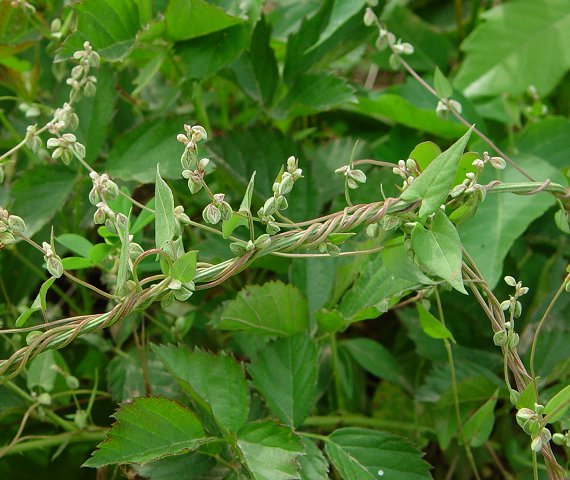Fallopia convolvulus (L.) . Lve
Black Bindweed

Introduced
CC = *
CW = 3
MOC = 32
© DETenaglia
Fallopia convolvulus (L.) . LveBlack Bindweed | |
 |
Introduced CC = * CW = 3 MOC = 32 |
© DETenaglia |
|
Family - Polygonaceae Habit - Annual forb with slender taproot, forming mats in open areas or more commonly climbing on adjacent vegetation. Stems - To 2 m, slender, spreading or climbing, twining, sparsely to moderately pubescent with minute, downwardcurved hairs, occasionally also somewhat mealy. Ocreae 2-4 mm long, oblique at the tip, the surface glabrous or minutely roughened, tan to greenish brown.
Leaves - Alternate, simple, petiolate. Petioles with a deep adaxial groove, retrorse strigose, to 2 cm. Blades 1-7 cm long, 0.8-6.0 cm wide, more or less heart-shaped to ovate-triangular, cordate at the base with the downward-pointing or occasionally spreading basal lobes rounded or pointed, tapered to a sharply pointed tip, the upper surface glabrous, the undersurface minutely roughened and often somewhat mealy, also gland-dotted.
Inflorescence - Axillary, spikelike racemes, the flowers 3-6 per fascicle, perfect, the flower stalks 1-3 mm long, not winged, jointed above the midpoint.
Flowers - Tepals 3-4 mm long at flowering, sometimes becoming enlarged to 4-5 mm at fruiting, those of the inner whorl mostly elliptic, those of the outer whorl obovate, angled to very short-tapered and not decurrent along the stalklike base, glabrous or sparsely and minutely hairy, white, sometimes pinkish-or purplish-tinged toward the base, the outer 3 tepals ridged dorsally or rarely with inconspicuous, slender wings to 0.9 mm wide at fruiting. Styles very short, fused most of their length, the stigmas capitate, entire along the margins. Stamens 6-8, not exserted. Anthers pinkish, bilobed, 0.3 mm broad. Filaments short, white, glabrous, 0.5 mm long. Ovary superior, green, glabrous, 3-angled, 0.7 mm long in flower. Styles 3, partially fused, short, green, glabrous, 0.1 mm long. Stigma green, capitate.
Fruits - Achenes, 3-sided, 2.3-3.5 mm long, the surface dull, appearing finely roughened or with dense, minute tubercles, black.
Flowering - May - November. Habitat - Bottomland forests, streambanks, bluffs, fields, gardens, railroads, roadsides, disturbed areas. Origin - Eurasia. Lookalikes - Fallopia scandens. Other info. - This species is scattered throughout Missouri, and may be more common than botanical records indicate due to its close resemblance to the very common F. scandens. The two can be distinguished by close examination of the achenes ("seeds"), which have shiny surfaces in the lookalike. Achenes of Fallopia convolvulus are dull in appearance. The plant is common across much of the northern and southwestern U.S., less so in Missouri, and uncommon in the southeast. Photographs taken off Hwy H, Shannon County, MO., 7-18-03 (DETenaglia); also at Marais Temps Clair Conservation Area, St. Charles County, MO, 7-22-2024 (SRTurner). |